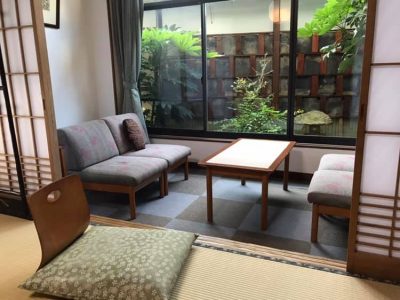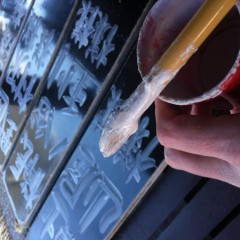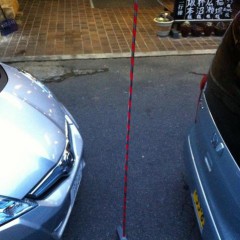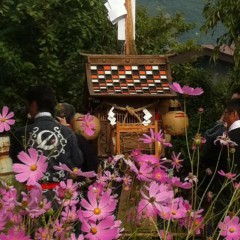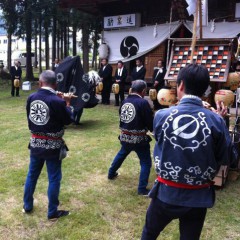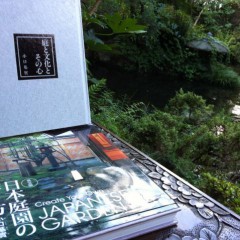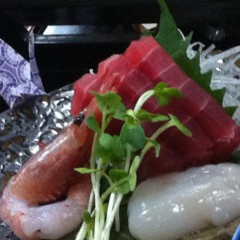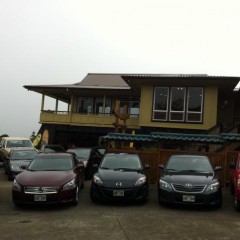お盆が終わって、少し落ち着いたから、
山登りへ!
若女将と戸倉上山田温泉の近くの八頭山を上りました。亀清旅館から見える山ので、その記念で一つの客室は「八頭」と言う名前です。
亀清旅館・戸倉上山田温泉から車で7.6km、約15分で坂上トンネルの入り口近辺が登山口です。割りと短いハイク(2.8㎞)ですが、標高790mの登山口から1204mの頂上までは標高差が約415mなので、良い運動になります。休憩しながら50分で登りました。途中のぽんぽぽ平から大林山へのトレールもあるので、次回は1333mの大林山をチャレンジしたいと思ってます。ルートの詳しくはここ。

After the O-Bon holiday, the inn has quieted down a bit so the proprietress and I got to go for a hike. We climbed the nearby 1204m tall Mt. Hattoh, which is visible from our inn and hence the namesake for one of our guest rooms. The trailhead is 7.6km (15 minutes by car) from our onsen town. The hike itself is relatively short (only 2.8km) aggressively climbs up 415 meters to the summit. With water breaks, it took us about 50 minutes.
近くで沢山のハイキングコースがあるからこそ、キャスケード山脈ハイキングで育った私には嬉しいです。それもあって、次の読売新聞(長野版)のコラムを書きました。9月14日掲載の予定で、編集前の文章:
「長野に来て、ホームシックにならない?」とよく聞かれます。
もちろん、家族に会いたいけど、あまり帰りたいと思わないのは古里のシアトルと長野は共通点が多いからかもしれません。
始めて長野に来たのは、1993年でした。大学卒業後で、更に日本語を習う為に日本に暫く過ごしたいと思って、英会話講師を目指しました。長野の学校で面接しに行くと言う事で、特急あさま(新幹線の前の時代)に乗って来ました。県境を渡った瞬間に雄大の山々が見えて、「ここは私の住む所だな」と一目惚れでした。シアトルではほぼ毎日キャスケード山脈やタホマ富士と言われるレーニア山を見てました。周りに山がないと落ち着かないので、私にとっては日本の屋根である信州は親しみやすい場所です。
未だに休みの日は高原ドライブや山登りに行ってます。今年の家族の夏休みは乗鞍登山と山小屋でした。そして冬はスキーやスノーシューです。新幹線は便利で気楽に東京へ行けるが、そのコンクリートジャングルより長野の山の方が私を呼んでます。
一旦シアトルに戻ったが、旅館の跡継ぎとして再びに長野に住む様になった時、その条件の一つは薪ストーブでした。森林の深い環境で育たれた影響か、自分にとっては薪ストーブが必須です。幸いに長野も薪ストーブが多いです。薪仲間も沢山できたし、選定物を分けてくれるりんご農家と親しくなりました。信州と古里の薪ストーブ繋がりもあって、嬉しいです。
食文化も共通点が多いです。例えば長野県も私の生まれのワシントン州もりんご王国です。(向こうにもフジアップルが主流です!)シアトルは港町で、ネイティブの文化もあってサーモン料理が盛んでいます。長野は海がないですが、信州サーモンはあります。長野に来ても、私の大好きなサーモンを食べられるのは有難いです。
そう言えば、古里は日本に影響されてご当地巻き寿司があります。皆さんはカリフォルニア巻きがご存知だと思いますが、シアトル巻きもあります。中身はスモークサーモンとクリームチーズです。長野巻きを作ったら、中身は何が良いでしょうかね?
